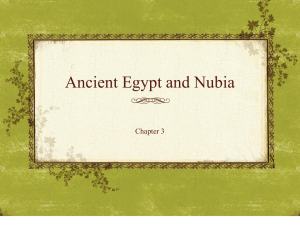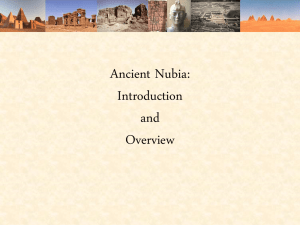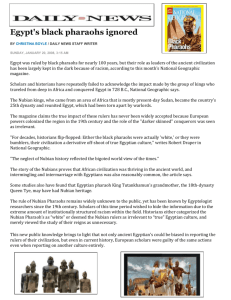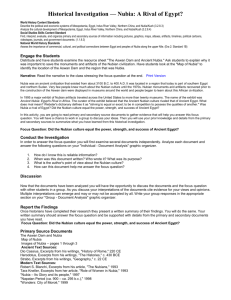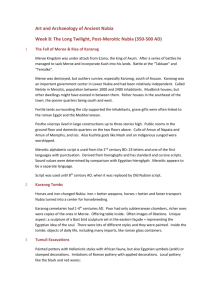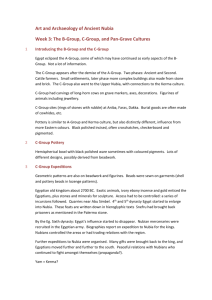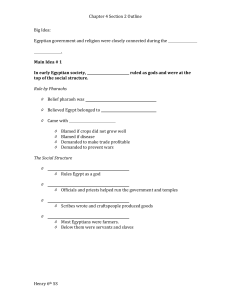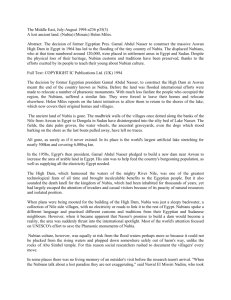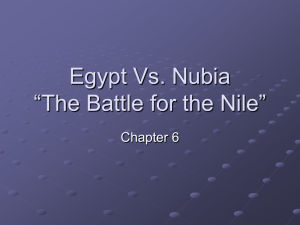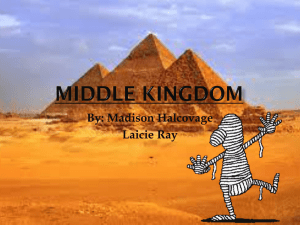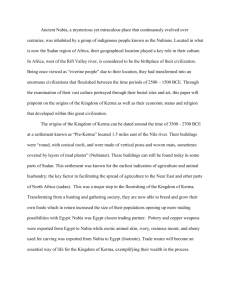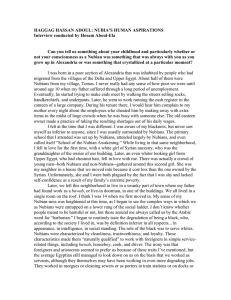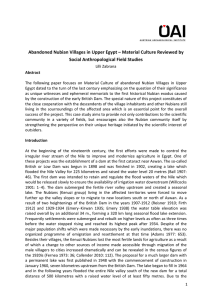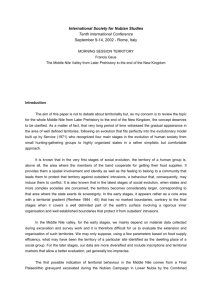Unit 1 - course notes
advertisement
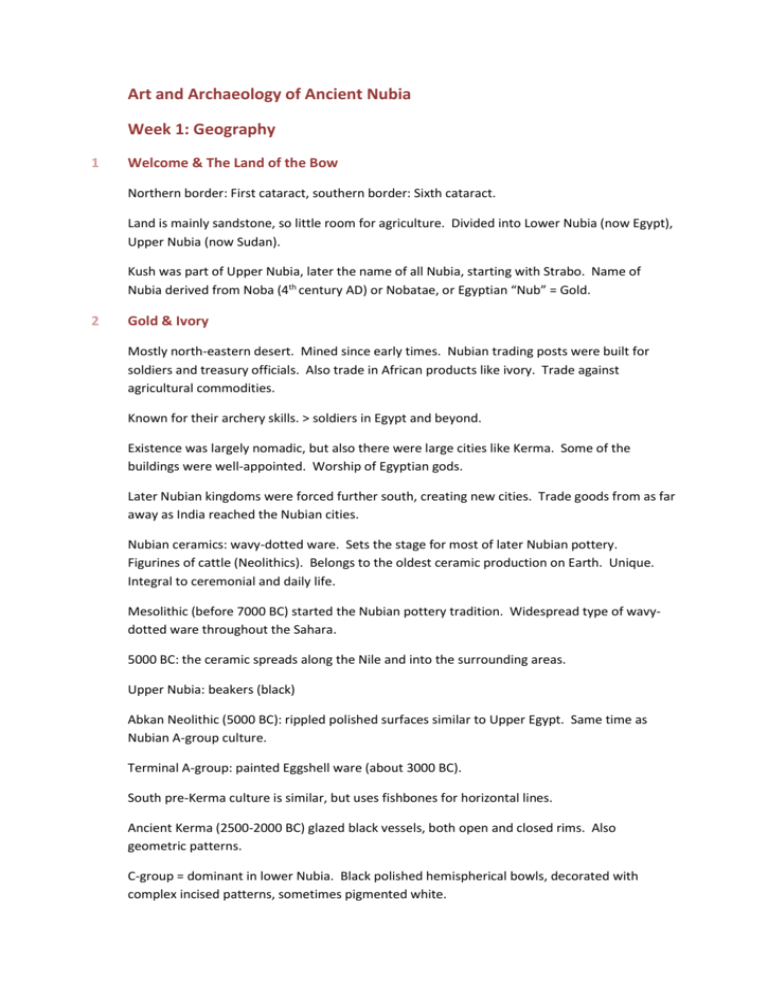
Art and Archaeology of Ancient Nubia Week 1: Geography 1 Welcome & The Land of the Bow Northern border: First cataract, southern border: Sixth cataract. Land is mainly sandstone, so little room for agriculture. Divided into Lower Nubia (now Egypt), Upper Nubia (now Sudan). Kush was part of Upper Nubia, later the name of all Nubia, starting with Strabo. Name of Nubia derived from Noba (4th century AD) or Nobatae, or Egyptian “Nub” = Gold. 2 Gold & Ivory Mostly north-eastern desert. Mined since early times. Nubian trading posts were built for soldiers and treasury officials. Also trade in African products like ivory. Trade against agricultural commodities. Known for their archery skills. > soldiers in Egypt and beyond. Existence was largely nomadic, but also there were large cities like Kerma. Some of the buildings were well-appointed. Worship of Egyptian gods. Later Nubian kingdoms were forced further south, creating new cities. Trade goods from as far away as India reached the Nubian cities. Nubian ceramics: wavy-dotted ware. Sets the stage for most of later Nubian pottery. Figurines of cattle (Neolithics). Belongs to the oldest ceramic production on Earth. Unique. Integral to ceremonial and daily life. Mesolithic (before 7000 BC) started the Nubian pottery tradition. Widespread type of wavydotted ware throughout the Sahara. 5000 BC: the ceramic spreads along the Nile and into the surrounding areas. Upper Nubia: beakers (black) Abkan Neolithic (5000 BC): rippled polished surfaces similar to Upper Egypt. Same time as Nubian A-group culture. Terminal A-group: painted Eggshell ware (about 3000 BC). South pre-Kerma culture is similar, but uses fishbones for horizontal lines. Ancient Kerma (2500-2000 BC) glazed black vessels, both open and closed rims. Also geometric patterns. C-group = dominant in lower Nubia. Black polished hemispherical bowls, decorated with complex incised patterns, sometimes pigmented white. Pan Grave Culture (eastern desert, red sea hills). Derived from similar common traditions as CGroup and Ancient Kerma. 3 Crossing the Cataracts Trade routes in Ancient Nubia. Very limited information. Nubians were inclined to herding and trading rather than agriculture. Larger settlements were usually in control of trade. Later centers like Napata, ideal spot for traders and travellers. When the Kushite kingdom moves south, trade with Africa increased in importance. 4 Who were the Nubians? Herodotus found them beautiful, the Egyptians were afraid of them and depicted them less kindly. Intermarriage between Egyptians and Nubians was common though, up to the pharaohs. Egyptians and Nubians have common ancestry and links to Africa and the Sahara. 5 Nubian Treasure Giuseppe Ferlini was a surgeon in the Egyptian army, heard about great treasure in the desert, near Khartum. He explored the sites in August 1840, eventually wound up at the site of Meroe. He also found the pyramid tombs nearby. First only bones inside, but then he found a large pyramid which he tore apart and found a chamber inside. Grave goods: vase, necklaces, stones, amulets, figures of gods. A second chamber had bronze vessels. The foundation contained the burial of Queen Amanesh Kento with all the treasure intact. He hid the finds before he was visited by bandits. He fled with the finds to Italy. Controversy: different from anything from Egypt, but eventually discussion went into the right way for Meroitic pyramids. Begarawiya was reopened later and the treasure was proved to come from the underground burial chamber. 6 Pens & Pyramids Nubia remained inaccessible to most travellers until the middle of the 19th century. Lepsius was invited to visit Egypt and Nubia to record things > drawings were published in a series of folios. 7 Island of Meroe End of the 19th century: excavations were added to archaeological practice. Meroe (200 km northeast of Khartum). John Garstang started to work on the margins of the Roman empire, worked in Meroe. He dug up the center of the city of Meroe, and recorded remnants of Meroitic stript. 8 The Birth of Nubian Archaeology Only 20th century when Nubian archaeology came into being. The Nile dams started to cover much of old Nubia. Reisner devised the ‘survey’. The survey began in 1907: recovery of material and reconstruction of the history of the district. The catalog is still the basis of Nubian archaeology. He started with the A-group (earliest unique culture) = archaic Egypt, ending with X-group (Byzantine), the rest of the letters could be added later. Lots of excavations followed. Kerma: Reisner concentrated further on Nubian history. He was urged to work further south in Kerma: a lush plain with mudbrick towns with earthen tumuli in cemetaries. Black pottery cups appeared, thus placing finds in Egypt in the right context. Variety of materials, glazed potter, daggers, etc. Kerma was the center of a large and powerful state. No mummification, but Nubian sleeping position burials. Sacrificial offerings of animals and humans! Large chapels, like the fufa where built. Religious structures surrounded by warehouses and workshops, including Egyptian imports for decoration. These imports made it look like an Egyptian outpost. Nowadays we see the indigenous growth to power. Frontier fortresss on the Second Cataract (Egyptian), south of Abu Simbel. Rich in gold and near the African trade. Belly of the Rocks = Second Cataracts. Dangerous passage. Middle kingdom Pharaohs built a series of forts to take care of the situation and being able to control the trade. Particular interest are the object of daily life of the soldiers families. The forts were reconstructed in the 18th dynasty, and some temples added. Then, the Egyptians lived more in peace with the locals. Gebel Barkal (near 4th cataract). Most important religious center of Kush, the Karnak of Nubia. After the 18th dynasty, the Egyptians started to build temples to administer Nubia. One of those is the one at Abu Simbel. Gebel Barkal was dedicated to Amon. This remained functioning long after the Egyptians had been pushed out again. The 25th dynasty was the Kushite Dynasty, founded by a Kushite king who conquered Egypt itself. Meroe had already been excavated, but Reisner was interested in the pyramids south of the city. Largely robbed out, but he still found a lot of exquisite items. After the Egyptians had raided the north, the Nubian centers moved south to Napata and Meroe. The Meroitic Nubians were also in contact with Romans and other cultures, with an own alphabet. Became a great empire probably extending influence far south of modern Khartoum. Roman commodities (baths, markets, etc) were commonplace. 24 BC a short war with Rome led to a peace treaty, leading to the decline of Meroe (also war with Aksum). Reisner excavated all four royal cemeteries in Nubia. 76 successive generations of rulers, Reisner built a genealogy of those rulers simply based on inscriptions. 9 The Mysterious X-Group Another raising of the dam > excavations at Ballana: royal tombs of the X-group culture, with influence of Byzantine styles, with remains of Egyptian and Nubian traditions. 10 The Drowning Land 1950s > Assuan dam raised again, Lake Nasser would cover most of lower Nubia, a salvage campaign was set up to save lots of stuff, including Abu Simbel. A new interest in Nubian archaeology grew as a result. Today, a new dams is being built in Sudan, near the 4th cataract, leading to even more salvage archaeology there.
